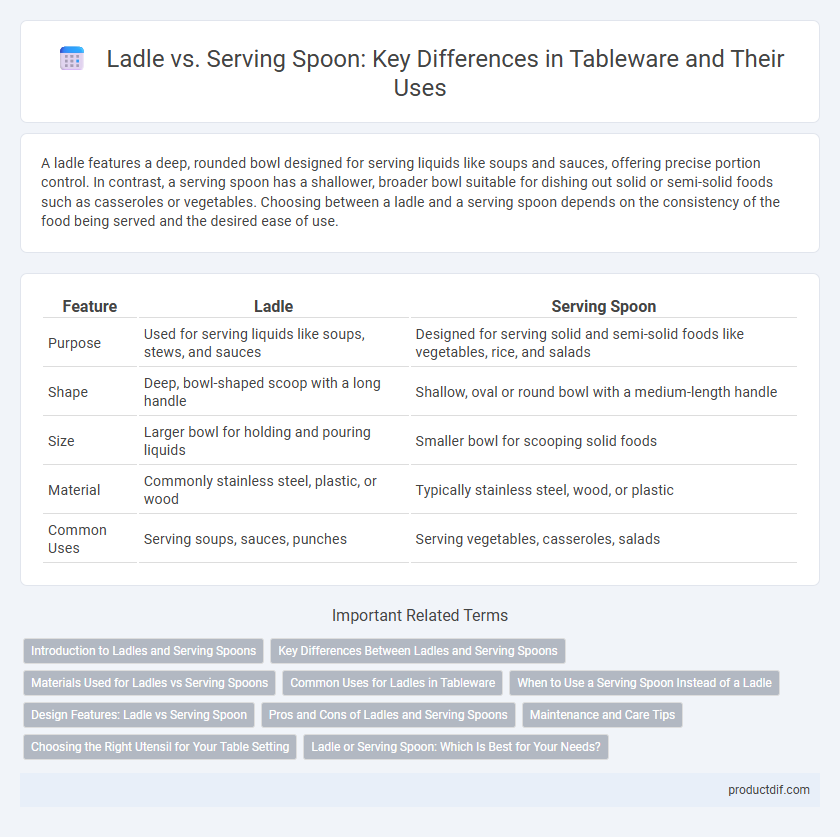A ladle features a deep, rounded bowl designed for serving liquids like soups and sauces, offering precise portion control. In contrast, a serving spoon has a shallower, broader bowl suitable for dishing out solid or semi-solid foods such as casseroles or vegetables. Choosing between a ladle and a serving spoon depends on the consistency of the food being served and the desired ease of use.
Table of Comparison
| Feature | Ladle | Serving Spoon |
|---|---|---|
| Purpose | Used for serving liquids like soups, stews, and sauces | Designed for serving solid and semi-solid foods like vegetables, rice, and salads |
| Shape | Deep, bowl-shaped scoop with a long handle | Shallow, oval or round bowl with a medium-length handle |
| Size | Larger bowl for holding and pouring liquids | Smaller bowl for scooping solid foods |
| Material | Commonly stainless steel, plastic, or wood | Typically stainless steel, wood, or plastic |
| Common Uses | Serving soups, sauces, punches | Serving vegetables, casseroles, salads |
Introduction to Ladles and Serving Spoons
Ladles and serving spoons are essential tableware pieces designed for different types of food serving tasks. Ladles typically feature deep, bowl-shaped heads and long handles ideal for dishing out soups, stews, and sauces, ensuring precise portion control and minimal spillage. Serving spoons have shallower, broader heads with shorter handles, making them versatile for serving solid or semi-solid dishes like vegetables, casseroles, and grains.
Key Differences Between Ladles and Serving Spoons
Ladles feature deep, bowl-shaped heads designed for scooping and serving liquids like soups, stews, and sauces, while serving spoons have shallow, flat, or slightly curved heads ideal for solid or semi-solid foods such as casseroles and vegetables. Ladles often have longer handles to reach into deep pots, whereas serving spoons have shorter handles suited for transferring food from serving dishes. Material and size variations also reflect their distinct functions, with ladles commonly made of heat-resistant materials and serving spoons prioritizing ease of serving diverse textures.
Materials Used for Ladles vs Serving Spoons
Ladles are commonly crafted from stainless steel, silicone, or heat-resistant plastic to withstand high temperatures and facilitate serving liquids like soups and sauces. Serving spoons often feature materials such as wood, stainless steel, or decorative ceramics, chosen for durability and aesthetic appeal during food presentation. Both utensils prioritize materials that balance functionality and resistance to wear, with ladles emphasizing heat resistance and serving spoons focusing on versatility and design.
Common Uses for Ladles in Tableware
Ladles are commonly used for serving soups, stews, and sauces, offering precise portion control and easy transfer from pot to plate. Their deep, bowl-shaped design makes them ideal for handling liquids and semi-liquids without spills. In tableware settings, ladles are essential for buffet-style service and communal meals, ensuring efficient and hygienic serving.
When to Use a Serving Spoon Instead of a Ladle
Use a serving spoon instead of a ladle when handling thicker or chunkier foods like casseroles, vegetables, or rice, as its shallow bowl and flat edge provide better control and portioning. Serving spoons excel in scooping and transferring solid or semi-solid dishes, preventing spills and allowing for more precise servings compared to the deep bowl of a ladle. Opt for a serving spoon during meals requiring gentle handling of mixed textures where a ladle's volume and depth might be cumbersome or excessive.
Design Features: Ladle vs Serving Spoon
Ladles feature a deep, bowl-shaped head designed for scooping and serving liquids such as soups and sauces, with a long handle to reach into pots. Serving spoons have a shallower, wider bowl optimized for solid or semi-solid foods, offering versatility for dishing out portions. The ergonomic handle lengths and shapes of both utensils reflect their specific functions, enhancing ease of use and control during serving.
Pros and Cons of Ladles and Serving Spoons
Ladles excel in serving liquids like soups and sauces with their deep bowl design, preventing spills and ensuring portion control, but their size can limit versatility for solid foods. Serving spoons offer greater adaptability for both solid and semi-solid dishes, featuring a broad, shallow bowl for easy scooping but may cause drips when handling liquids. Selecting between ladles and serving spoons depends on the specific use case, balancing precision in liquid servings against multifunctional usability in diverse tableware settings.
Maintenance and Care Tips
Ladles and serving spoons require proper cleaning to maintain their durability and hygiene; hand washing with mild detergent prevents damage to finishes and extends lifespan. Avoid soaking wooden handles for extended periods to prevent cracking, and dry utensils thoroughly to inhibit rust on metal parts. Regular inspection for wear and timely replacement ensures safety and optimal functionality during food service.
Choosing the Right Utensil for Your Table Setting
Selecting the ideal utensil for your table setting depends on the dish being served and portion control needs. Ladles, typically deeper and larger, excel at serving soups, stews, and punch, allowing for efficient scooping of liquids and larger portions. Serving spoons, with their shallower, broader bowls, are better suited for solid dishes such as vegetables, casseroles, and rice, providing ease in portioning and presenting food elegantly.
Ladle or Serving Spoon: Which Is Best for Your Needs?
A ladle is ideal for serving liquids like soups, stews, and sauces due to its deep bowl and long handle, providing ease and precision without spills. Serving spoons, featuring a shallow, wide bowl, excel in portioning solid or semi-solid foods such as casseroles, vegetables, and rice. Choosing between a ladle and a serving spoon depends on the type of food being served and the ease of handling desired.
Ladle vs Serving Spoon Infographic

 productdif.com
productdif.com